Difference between revisions of "DW-LC10"
(Created page with "{{RevisionChanger | hasA = 1 | hasB = 1 | hasC = 1}} {{Infobox module | name = DW-LC10.C | image = DW-LC10C.png | outCount = 10 | dimmOut = | peakl = 16A...") |
(Marked this version for translation) |
||
| (15 intermediate revisions by 2 users not shown) | |||
| Line 1: | Line 1: | ||
| + | <languages/> | ||
| + | <translate> | ||
| + | <!--T:1--> | ||
{{RevisionChanger | hasA = 1 | hasB = 1 | hasC = 1}} | {{RevisionChanger | hasA = 1 | hasB = 1 | hasC = 1}} | ||
{{Infobox module | {{Infobox module | ||
| name = DW-LC10.C | | name = DW-LC10.C | ||
| − | | image = DW- | + | | image = DW-LC10С.png |
| outCount = 10 | | outCount = 10 | ||
| dimmOut = | | dimmOut = | ||
| Line 14: | Line 17: | ||
}} | }} | ||
| − | == | + | ==10-CHANNEL ACTUATOR== <!--T:2--> |
| + | <!--T:3--> | ||
This module is designed for high power AC/DC circuits commutation. | This module is designed for high power AC/DC circuits commutation. | ||
Applicable for light, power sockets, for control of fan coil units, locks, blinds/gates. | Applicable for light, power sockets, for control of fan coil units, locks, blinds/gates. | ||
| − | ==Features== | + | ==Features== <!--T:4--> |
*Control of a wide range of devices: | *Control of a wide range of devices: | ||
**Lights | **Lights | ||
| Line 30: | Line 34: | ||
*Relays with AgSnO2 contacts rated for 16A continuous load and 120A 20ms inrush current | *Relays with AgSnO2 contacts rated for 16A continuous load and 120A 20ms inrush current | ||
*Low noise relay switching | *Low noise relay switching | ||
| − | |||
*Built-in logical unit | *Built-in logical unit | ||
*Plug and play feature | *Plug and play feature | ||
*Regular software updates | *Regular software updates | ||
| + | <!--T:5--> | ||
<div class="caution"> | <div class="caution"> | ||
CAUTION! All work related to the installation, connection, setting up, service and support must be carried out by qualified personnel with sufficient skills and experience in working with electrical equipment. | CAUTION! All work related to the installation, connection, setting up, service and support must be carried out by qualified personnel with sufficient skills and experience in working with electrical equipment. | ||
| Line 51: | Line 55: | ||
</div> | </div> | ||
| − | ==Overview== | + | ==Overview== <!--T:6--> |
| + | <!--T:7--> | ||
[[File:LC10C VIEW.png|500px]] | [[File:LC10C VIEW.png|500px]] | ||
| − | ==Example of connection== | + | ==Example of connection== <!--T:8--> |
| + | <!--T:9--> | ||
[[File:LC10C EXA.png|500px]] | [[File:LC10C EXA.png|500px]] | ||
| − | ==Module dimensions== | + | ==Module dimensions== <!--T:10--> |
| + | <!--T:11--> | ||
[[File:LC10C DIMM.png|500px]] | [[File:LC10C DIMM.png|500px]] | ||
| − | ==Module parameters== | + | ==Module parameters== <!--T:12--> |
| + | <!--T:13--> | ||
{{ Mp | {{ Mp | ||
| outqty = 10 | | outqty = 10 | ||
| Line 84: | Line 92: | ||
}} | }} | ||
| − | ==Connectivity recommendations== | + | ==Connectivity recommendations== <!--T:14--> |
| + | <!--T:15--> | ||
In order to protect the actuator and loads connected to it, installing a circuit breaker is recommended. | In order to protect the actuator and loads connected to it, installing a circuit breaker is recommended. | ||
The nominal value of the circuit breaker should be calculated based on the maximum total load of connected | The nominal value of the circuit breaker should be calculated based on the maximum total load of connected | ||
| Line 93: | Line 102: | ||
for each load. | for each load. | ||
| − | ==Connection of actuators== | + | ==Connection of actuators== <!--T:16--> |
| + | <!--T:17--> | ||
<div class="caution"> Caution: Before applying power to the module, you must properly configure the outputs in the application. The contacts configured incorrectly can lead to simultaneous power supply to both channels, resulting in the module failure and/or failure of the equipment connected to it, and even a fire. | <div class="caution"> Caution: Before applying power to the module, you must properly configure the outputs in the application. The contacts configured incorrectly can lead to simultaneous power supply to both channels, resulting in the module failure and/or failure of the equipment connected to it, and even a fire. | ||
If free (unused) channels remain in a given group after a curtain/jalousie/shutter actuator with low-voltage control or gate actuator has been connected to it, these channels need to be left unused. (Do not connect other devices to them!) </div> | If free (unused) channels remain in a given group after a curtain/jalousie/shutter actuator with low-voltage control or gate actuator has been connected to it, these channels need to be left unused. (Do not connect other devices to them!) </div> | ||
| − | ===Connection of the lights/electric contactor/heating thermal actuator=== | + | ===Connection of the lights/electric contactor/heating thermal actuator=== <!--T:18--> |
| + | <!--T:19--> | ||
[[File:lamps.png|200px]]<br> | [[File:lamps.png|200px]]<br> | ||
Sample HW for this configuration | Sample HW for this configuration | ||
<syntaxhighlight lang="xml" line> | <syntaxhighlight lang="xml" line> | ||
| − | hw="out='LLL | + | hw="out='LLL-------'" |
</syntaxhighlight> | </syntaxhighlight> | ||
| + | ===Connection of high load device=== <!--T:20--> | ||
| − | + | <!--T:21--> | |
| − | |||
{| class="wikitable" style="width:800px"; | {| class="wikitable" style="width:800px"; | ||
|- | |- | ||
| Line 117: | Line 128: | ||
|} | |} | ||
| − | ===Connection of curtain/jalousie/shutter actuator with 220V force control=== | + | ===Connection of curtain/jalousie/shutter actuator with 220V force control=== <!--T:22--> |
| + | <!--T:23--> | ||
[[File:Pjalousie.png|200px]]<br> | [[File:Pjalousie.png|200px]]<br> | ||
Sample HW for this configuration | Sample HW for this configuration | ||
<syntaxhighlight lang="xml" line> | <syntaxhighlight lang="xml" line> | ||
| − | hw="out='B | + | hw="out='B---------'" |
</syntaxhighlight> | </syntaxhighlight> | ||
| − | ===Connection of curtain/jalousie/shutter actuator with low-voltage control=== | + | ===Connection of curtain/jalousie/shutter actuator with low-voltage control=== <!--T:24--> |
| + | <!--T:25--> | ||
[[File:Ljalousie.png|200px]]<br> | [[File:Ljalousie.png|200px]]<br> | ||
Sample HW for this configuration | Sample HW for this configuration | ||
<syntaxhighlight lang="xml" line> | <syntaxhighlight lang="xml" line> | ||
| − | hw="out='B | + | hw="out='B---------'" |
</syntaxhighlight> | </syntaxhighlight> | ||
| − | ===Connection of single-pole gate actuator=== | + | ===Connection of single-pole gate actuator=== <!--T:26--> |
| + | <!--T:27--> | ||
[[File:1pgate.png|200px]]<br> | [[File:1pgate.png|200px]]<br> | ||
Sample HW for this configuration | Sample HW for this configuration | ||
<syntaxhighlight lang="xml" line> | <syntaxhighlight lang="xml" line> | ||
| − | hw="out='X | + | hw="out='X---------'" |
</syntaxhighlight> | </syntaxhighlight> | ||
| − | ===Connection of double-pole gate actuator=== | + | ===Connection of double-pole gate actuator=== <!--T:28--> |
| + | <!--T:29--> | ||
[[File:2pgate.png|200px]]<br> | [[File:2pgate.png|200px]]<br> | ||
Sample HW for this configuration | Sample HW for this configuration | ||
<syntaxhighlight lang="xml" line> | <syntaxhighlight lang="xml" line> | ||
| − | hw="out='G | + | hw="out='G---------'" |
</syntaxhighlight> | </syntaxhighlight> | ||
| + | ===Connection of single-pole water/gas supply valve=== <!--T:30--> | ||
| − | + | <!--T:31--> | |
| − | |||
| − | |||
[[File:1pvalve.png|200px]]<br> | [[File:1pvalve.png|200px]]<br> | ||
Sample HW for this configuration | Sample HW for this configuration | ||
<syntaxhighlight lang="xml" line> | <syntaxhighlight lang="xml" line> | ||
| − | hw="out='R | + | hw="out='R---------'" |
</syntaxhighlight> | </syntaxhighlight> | ||
| − | ===Connection of double-pole water/gas supply valve=== | + | ===Connection of double-pole water/gas supply valve=== <!--T:32--> |
| + | <!--T:33--> | ||
[[File:2pvalve.png|200px]]<br> | [[File:2pvalve.png|200px]]<br> | ||
Sample HW for this configuration | Sample HW for this configuration | ||
<syntaxhighlight lang="xml" line> | <syntaxhighlight lang="xml" line> | ||
| − | hw="out='V | + | hw="out='V---------'" |
</syntaxhighlight> | </syntaxhighlight> | ||
| − | ===Connection of fancoil control unit=== | + | ===Connection of fancoil control unit=== <!--T:34--> |
| + | <!--T:35--> | ||
[[File:fancoil.png|200px]]<br> | [[File:fancoil.png|200px]]<br> | ||
Sample HW for this configuration | Sample HW for this configuration | ||
<syntaxhighlight lang="xml" line> | <syntaxhighlight lang="xml" line> | ||
| − | hw="out='FFF | + | hw="out='FFF-------'" |
</syntaxhighlight> | </syntaxhighlight> | ||
| − | ==Indication of module operation== | + | |
| + | ==Indication of module operation== <!--T:36--> | ||
===Bootloader=== | ===Bootloader=== | ||
{{indication| textBBB= Waiting for bootloader command}} | {{indication| textBBB= Waiting for bootloader command}} | ||
| Line 185: | Line 202: | ||
}} | }} | ||
| − | ==Module installation and connection procedure== | + | ==Module installation and connection procedure== <!--T:37--> |
| + | <!--T:38--> | ||
*Install the module in the switchboard on the DIN rail and fix it with the special latch on the module base. | *Install the module in the switchboard on the DIN rail and fix it with the special latch on the module base. | ||
*Connect the CAN connector. | *Connect the CAN connector. | ||
| − | *Connect the channels (1- | + | *Connect the channels (1-10). |
*Configure the module using LT setup. | *Configure the module using LT setup. | ||
*Apply power to the load. | *Apply power to the load. | ||
*Check all equipment for proper operation. | *Check all equipment for proper operation. | ||
| − | ==Module shut-off and deinstallation procedure== | + | ==Module shut-off and deinstallation procedure== <!--T:39--> |
| + | <!--T:40--> | ||
*Disconnect the power from the load. | *Disconnect the power from the load. | ||
| − | *Disconnect the channels (1- | + | *Disconnect the channels (1-10). |
*Disconnect the CAN connector. | *Disconnect the CAN connector. | ||
*Remove the module from the DIN rail, releasing the latch at the bottom of the module base. | *Remove the module from the DIN rail, releasing the latch at the bottom of the module base. | ||
| − | ==HW settings== | + | ==HW settings== <!--T:41--> |
{|class="wikitable" | {|class="wikitable" | ||
|- | |- | ||
| Line 218: | Line 237: | ||
|stop||Char ‘R’||1-9||–||(for 2-pole gate and blinds) If it is declared then by Stop command during the motion, the same impulse appears as it was at the beginning of the motion. Pole, an which the stop-impules is formed, is defined by the parameter Stop value. If it is ‘r’ or ‘R’ then stop-impulse is produced on the opposite to the start-impulse pole. If any other value is delcared (e.g., ‘d’ ) then the stop-impulse is on the same pole. If a Runtime passed after the beginning of the motion then the stop-impulse is not formed. Example: stop=’r’ | |stop||Char ‘R’||1-9||–||(for 2-pole gate and blinds) If it is declared then by Stop command during the motion, the same impulse appears as it was at the beginning of the motion. Pole, an which the stop-impules is formed, is defined by the parameter Stop value. If it is ‘r’ or ‘R’ then stop-impulse is produced on the opposite to the start-impulse pole. If any other value is delcared (e.g., ‘d’ ) then the stop-impulse is on the same pole. If a Runtime passed after the beginning of the motion then the stop-impulse is not formed. Example: stop=’r’ | ||
|- | |- | ||
| − | |out||char[ | + | |out||char[10]||98||'LLLLLLLLLL'||Each char is responsible for the type of a particular channel |
*'L'-Lamp; | *'L'-Lamp; | ||
*'M'-Lamp Inverse; | *'M'-Lamp Inverse; | ||
| Line 246: | Line 265: | ||
|} | |} | ||
| + | <!--T:42--> | ||
<syntaxhighlight lang="xml" line> | <syntaxhighlight lang="xml" line> | ||
<item addr="300:1" cfgid="98" hw="runtime=60" name="Jalousie" sub-type="120" type="jalousie" uniq_id="117"/> | <item addr="300:1" cfgid="98" hw="runtime=60" name="Jalousie" sub-type="120" type="jalousie" uniq_id="117"/> | ||
| Line 265: | Line 285: | ||
<item addr="300:98" cfgid="98" hw="out='BLGKHJ-X'" name="Temperature" system="yes" type="temperature-sensor" uniq_id="107"/> | <item addr="300:98" cfgid="98" hw="out='BLGKHJ-X'" name="Temperature" system="yes" type="temperature-sensor" uniq_id="107"/> | ||
</syntaxhighlight> | </syntaxhighlight> | ||
| + | </translate> | ||
Latest revision as of 14:05, 1 January 2022
| DW-LC10.C | |||||||
|---|---|---|---|---|---|---|---|
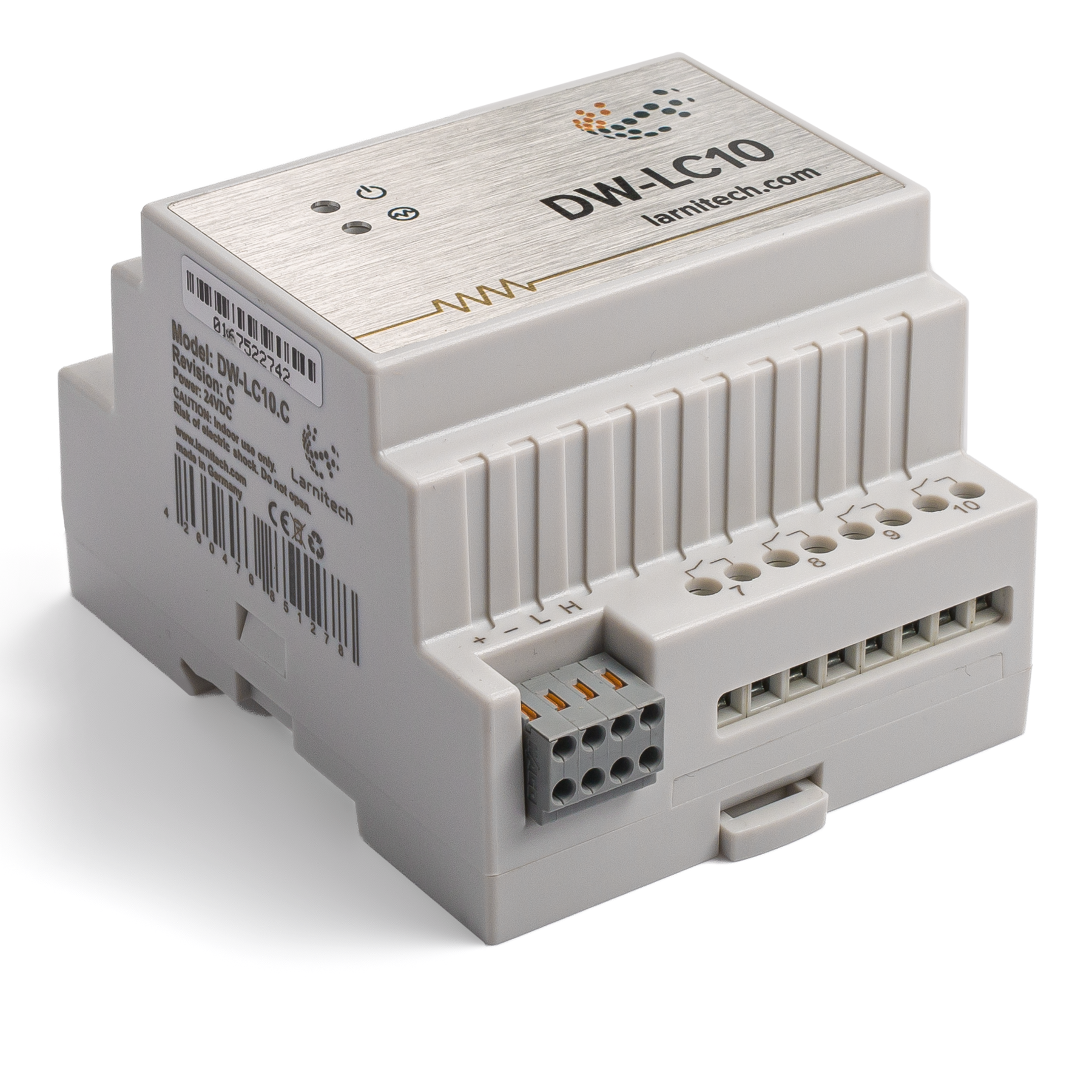 | |||||||
| |||||||
| |||||||
10-CHANNEL ACTUATOR
This module is designed for high power AC/DC circuits commutation. Applicable for light, power sockets, for control of fan coil units, locks, blinds/gates.
Features
- Control of a wide range of devices:
- Lights
- NC/NO heating valves
- Blinds
- 1 or 2-pole gates
- 1 or 2-pole valves
- NC/NO locks
- Fan coil units
- Relays with AgSnO2 contacts rated for 16A continuous load and 120A 20ms inrush current
- Low noise relay switching
- Built-in logical unit
- Plug and play feature
- Regular software updates
CAUTION! All work related to the installation, connection, setting up, service and support must be carried out by qualified personnel with sufficient skills and experience in working with electrical equipment. To avoid the risk of fire, electric shock, damage to the system and/or personal injury, the system installation and assembly must be performed in accordance with the instructions listed below:
- all connectivity work must be carried out with the power turned OFF;
- use appropriate tools and personal protection against electric shock;
- do not use damaged cables, wires and connectors;
- avoid folding the cables and wires;
- do not apply excessive force to the wires by kinking or pressing them too hard: the inner conductors of the cables and wires may get stripped or damaged;
- do not use the power socket with poor contacts to connect;
- do not exceed the load limit parameters specified in the manual;
- the supply conductors wire section is subject to the specifications for current density limit, insulation type and wire material. Light section can result in cable overheating and fire.
When the power is on, NEVER:
- connect/disconnect the connectors;
- open modules and sensors.
Overview
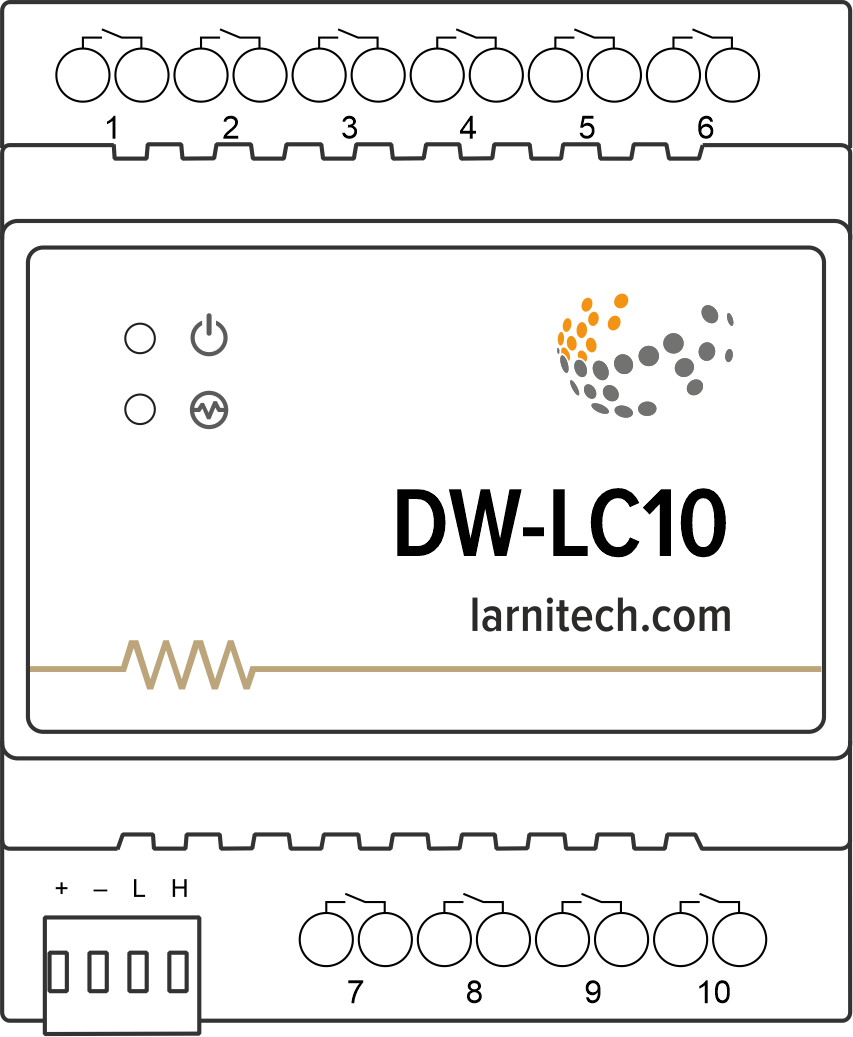
Example of connection
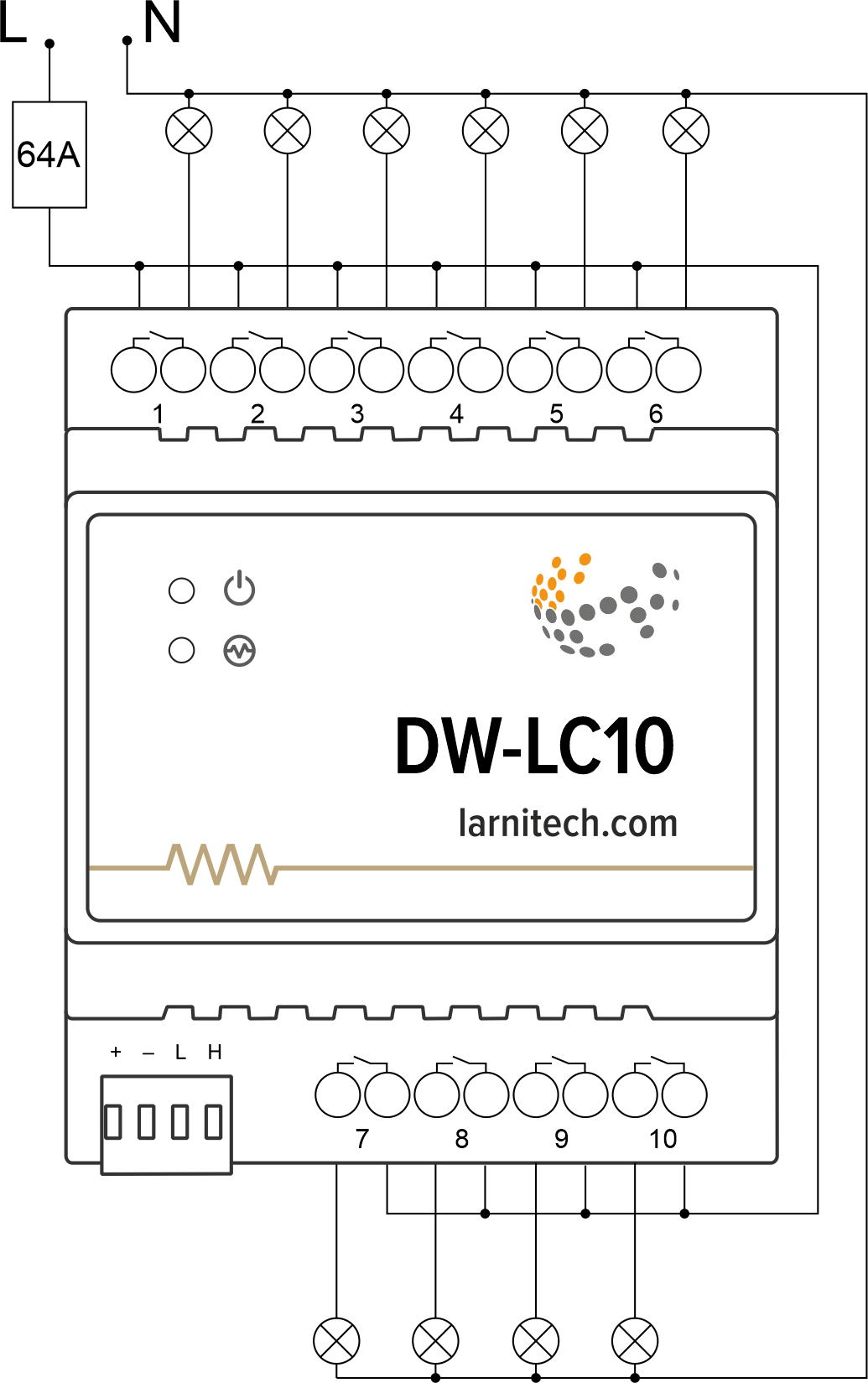
Module dimensions
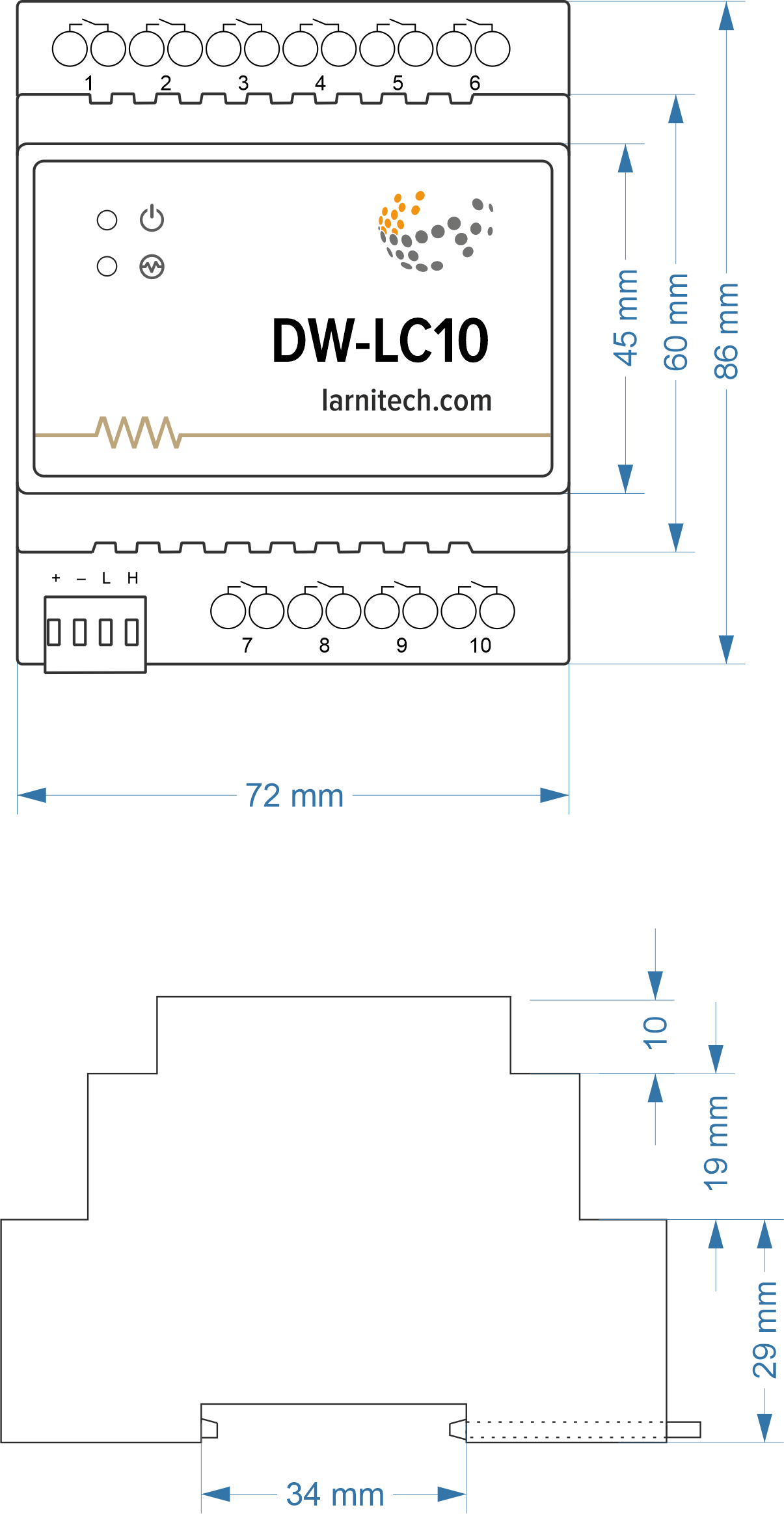
Module parameters
| Parameter name | Value |
|---|---|
| Output channels qty | 10 |
| Input voltage | 0-250V |
| Current type | AC/DC |
| Max load per channel | 16A |
| Power supply | 11.5 … 27.5 V DC from CAN |
| Max current(24V) | 200 mA |
| Permissible section of power supply cable to connect in socket: single-conductor cable multiple-conductor cable tipped multiple-conductor cable |
0.5 … 4mm2 0.5 … 4mm2 0.5 … 2.5mm2 |
| Bus type | CAN (4-wire) |
| Equipment installation type | DIN rail (EN 60715) |
| Case material | ABS |
| Protection | IP40 |
| Temperature range | -10 … +50 °C |
| Size | 4U, 69x115x58 mm |
| Weight | 250 g |
Connectivity recommendations
In order to protect the actuator and loads connected to it, installing a circuit breaker is recommended. The nominal value of the circuit breaker should be calculated based on the maximum total load of connected devices and at the same time should not significantly exceed the maximum permissible characteristics of the actuator. Depending on the requirements, you can use one circuit breaker for one actuator (it is recommended) or one circuit breaker per each group of connected loads, or, if necessary, a separate circuit breaker can be installed for each load.
Connection of actuators
Connection of the lights/electric contactor/heating thermal actuator
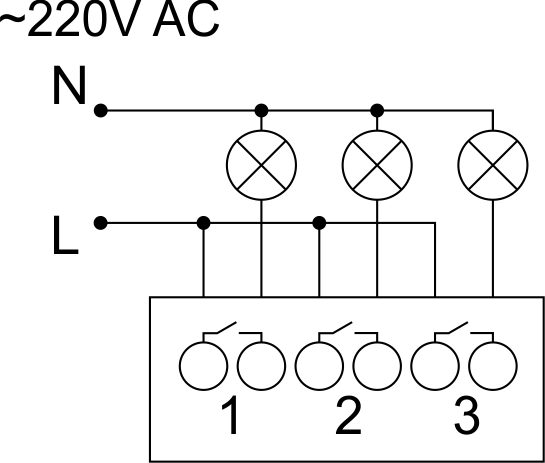
Sample HW for this configuration
1hw="out='LLL-------'"
Connection of high load device
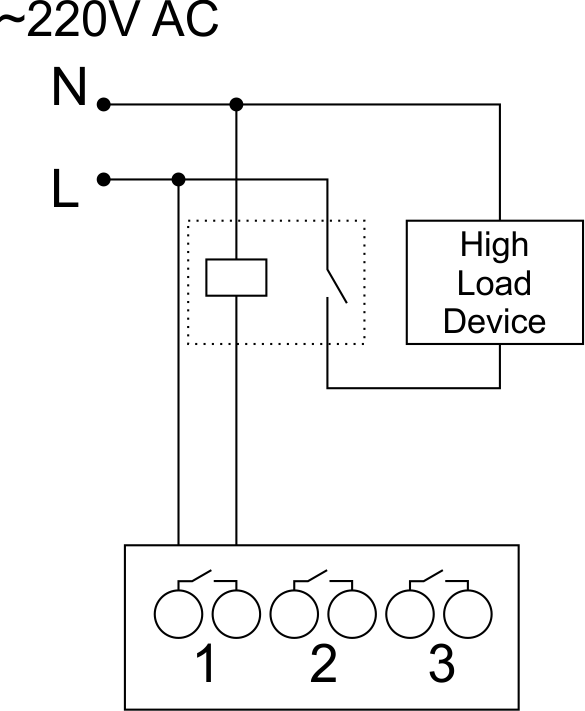 |
Recomended contactors:
|
Connection of curtain/jalousie/shutter actuator with 220V force control
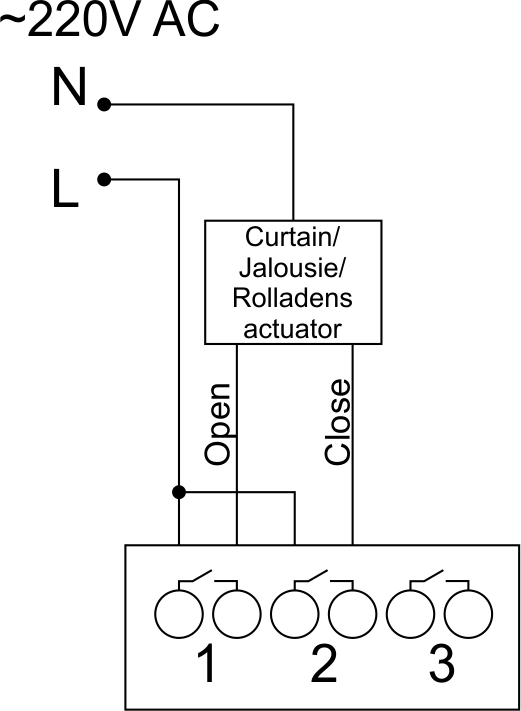
Sample HW for this configuration
1hw="out='B---------'"
Connection of curtain/jalousie/shutter actuator with low-voltage control
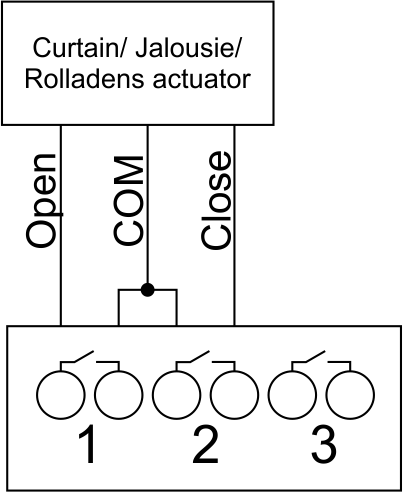
Sample HW for this configuration
1hw="out='B---------'"
Connection of single-pole gate actuator
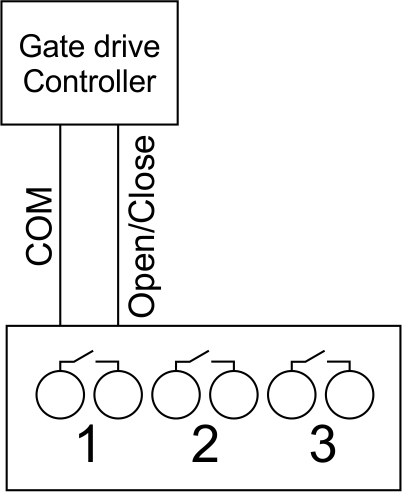
Sample HW for this configuration
1hw="out='X---------'"
Connection of double-pole gate actuator
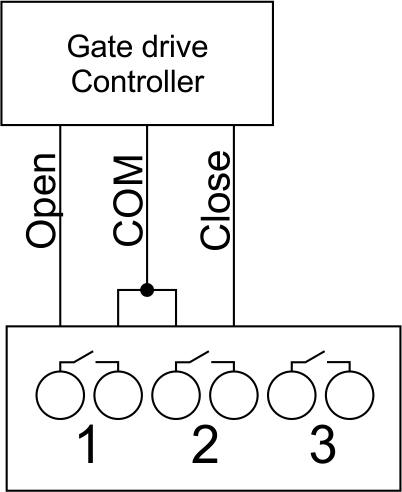
Sample HW for this configuration
1hw="out='G---------'"
Connection of single-pole water/gas supply valve
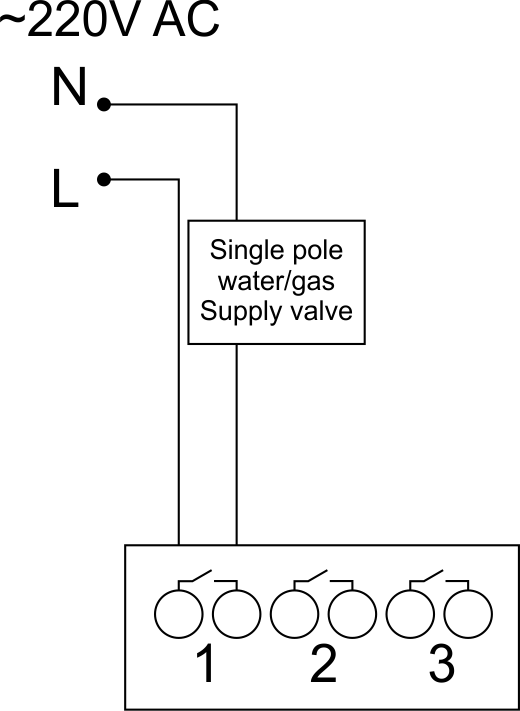
Sample HW for this configuration
1hw="out='R---------'"
Connection of double-pole water/gas supply valve
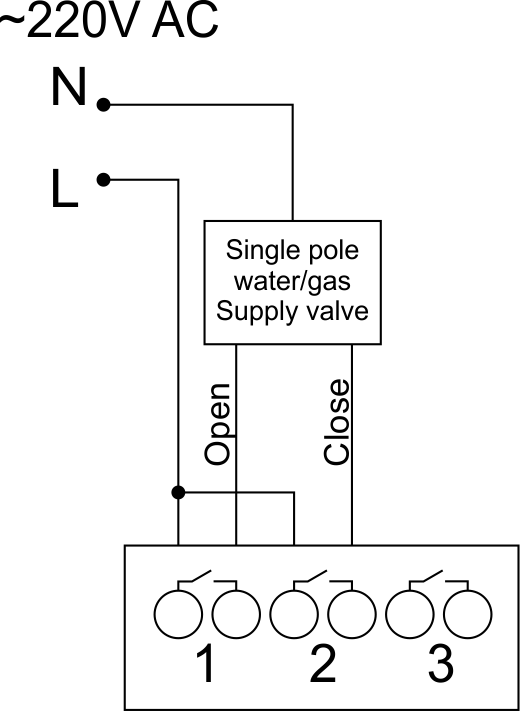
Sample HW for this configuration
1hw="out='V---------'"
Connection of fancoil control unit
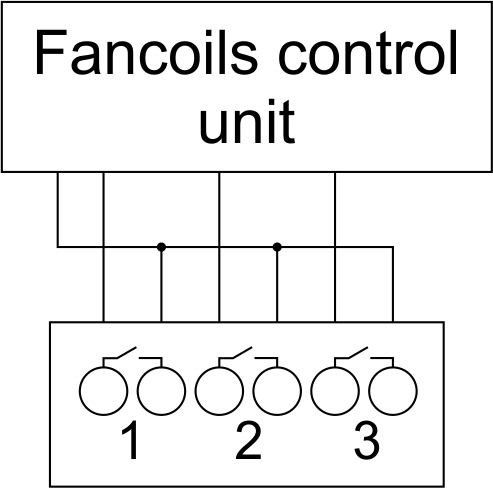
Sample HW for this configuration
1hw="out='FFF-------'"
Indication of module operation
Bootloader
| Indicator | Status | Description |
|---|---|---|
| Device in bootloader | ||
| Downloading firmware | ||
| Flashing firmware |
Firmware
| Indicator | Status | Description |
|---|---|---|
| Identification | ||
| Operational mode | ||
Error | ||
| Lost connection to server | ||
| Overheat |
Module installation and connection procedure
- Install the module in the switchboard on the DIN rail and fix it with the special latch on the module base.
- Connect the CAN connector.
- Connect the channels (1-10).
- Configure the module using LT setup.
- Apply power to the load.
- Check all equipment for proper operation.
Module shut-off and deinstallation procedure
- Disconnect the power from the load.
- Disconnect the channels (1-10).
- Disconnect the CAN connector.
- Remove the module from the DIN rail, releasing the latch at the bottom of the module base.
HW settings
| Name | Type, range | SUBID | Default | Description |
|---|---|---|---|---|
| runtime | integer 0-100 | 1-10 | 15 | runtime is the open/close time in seconds, is used for jalousie, gate, valve(2 pole); Example: runtime=15 |
| runtimeopen | integer 0-60000 | Blinds subId | – | Runtimeopen is the open time in milliseconds, is used for blinds; Example: runtimeopen=15000 |
| runtimeclose | integer 0-60000 | Blinds subId | – | Runtimeclose is the close time in milliseconds, is used for blinds; Example: runtimeclose=15000 |
| hold | integer 0-10000 | 1-10 | 500 | hold is the bridging time in miliseconds, is used for gate and jalousie (by default hold is the same as runtime), lock; Example: hold=3500 |
| def | string 'ON' | 1-10 | 'OFF' | def is the element status is set after restart, is used for lamp, heating, valve(1 pole); Example: def='ON' |
| stop | Char ‘R’ | 1-9 | – | (for 2-pole gate and blinds) If it is declared then by Stop command during the motion, the same impulse appears as it was at the beginning of the motion. Pole, an which the stop-impules is formed, is defined by the parameter Stop value. If it is ‘r’ or ‘R’ then stop-impulse is produced on the opposite to the start-impulse pole. If any other value is delcared (e.g., ‘d’ ) then the stop-impulse is on the same pole. If a Runtime passed after the beginning of the motion then the stop-impulse is not formed. Example: stop=’r’ |
| out | char[10] | 98 | 'LLLLLLLLLL' | Each char is responsible for the type of a particular channel
Example: out='BGLKMVX' |
1<item addr="300:1" cfgid="98" hw="runtime=60" name="Jalousie" sub-type="120" type="jalousie" uniq_id="117"/>
2<item addr="300:3" auto-period="600" cfgid="98" hw="def='ON'" name="Lamp" type="lamp" uniq_id="110"/>
3<item addr="300:4" cfgid="98" hw="runtime=30" name="Gate" sub-type="120" type="gate" uniq_id="118"/>
4<item addr="300:6" auto-period="600" cfgid="98" hw="hold=5000" name="Lamp" type="lamp" uniq_id="113"/>
5<item addr="300:7" cfgid="98" hw="def='ON'" name="Radiator" type="valve-heating" uniq_id="119">
6 <automation name="Eco" temperature-level="16" uniq_id="120"/>
7 <automation name="Comfort" temperature-level="22" uniq_id="121"/>
8 <automation name="Hot" temperature-level="25" uniq_id="122"/>
9</item>
10<item addr="300:8" cfgid="98" hw="def='ON'" name="Radiator" type="valve-heating" uniq_id="123">
11 <automation name="Eco" temperature-level="16" uniq_id="124"/>
12 <automation name="Comfort" temperature-level="22" uniq_id="125"/>
13 <automation name="Hot" temperature-level="25" uniq_id="126"/>
14</item>
15<item addr="300:10" cfgid="98" hw="hold=2000" name="Gate" sub-type="120" type="gate" uniq_id="127"/>
16<item addr="300:97" cfgid="98" name="Temperature" system="yes" type="temperature-sensor" uniq_id="106"/>
17<item addr="300:98" cfgid="98" hw="out='BLGKHJ-X'" name="Temperature" system="yes" type="temperature-sensor" uniq_id="107"/>